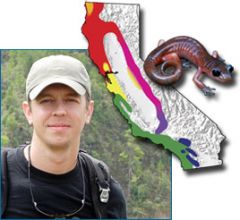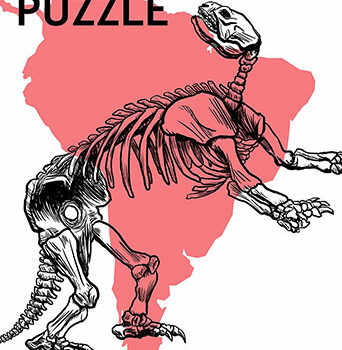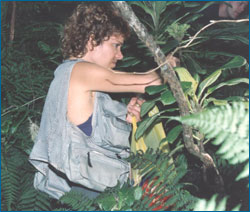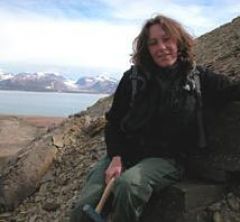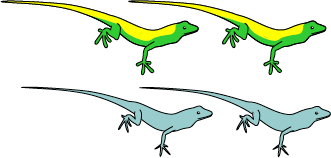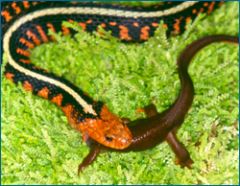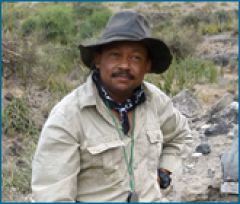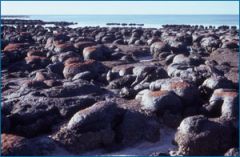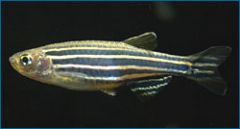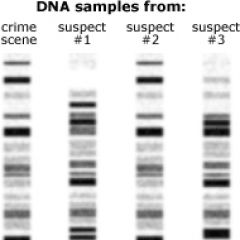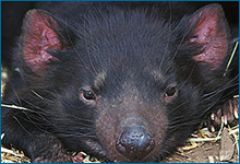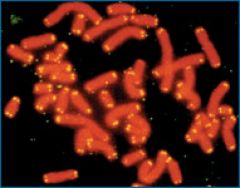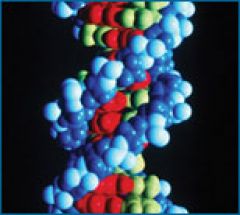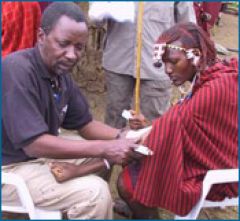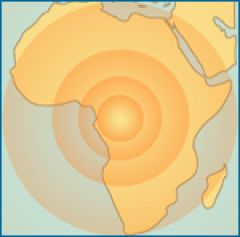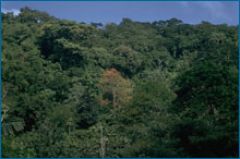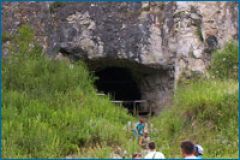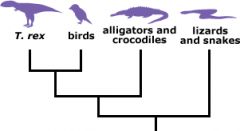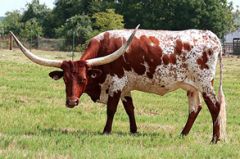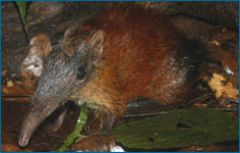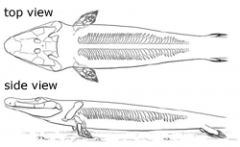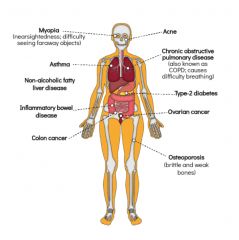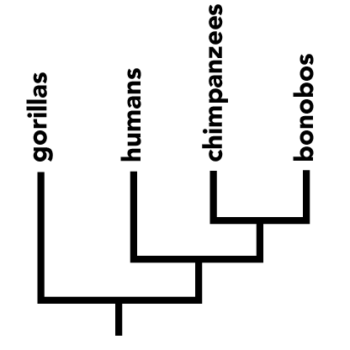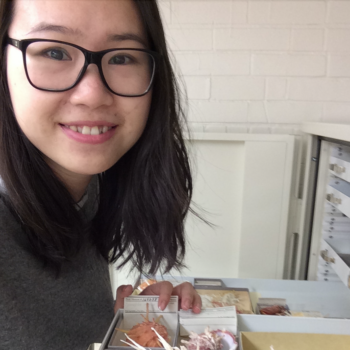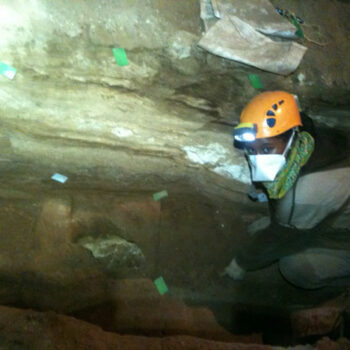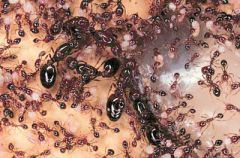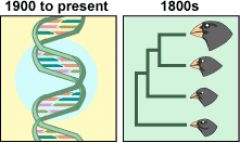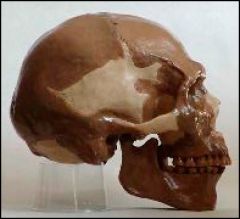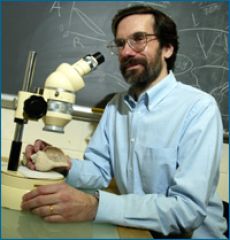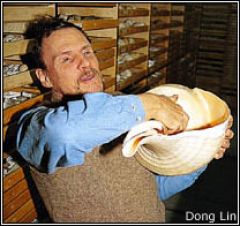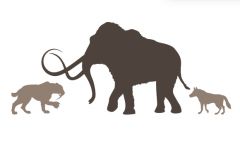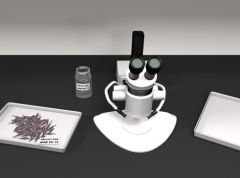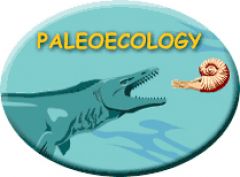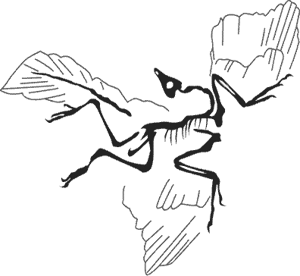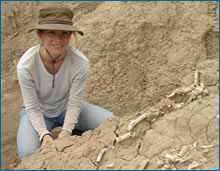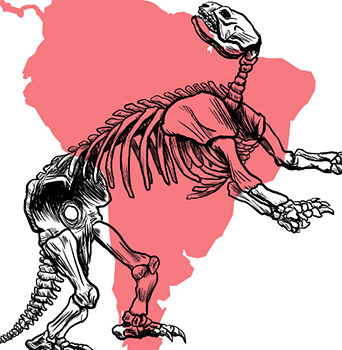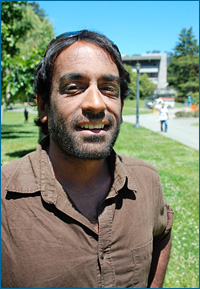Found 61 resources for the concept:
Scientists can test ideas about events and processes long past, very distant, and not directly observable.
A closer look at a classic ring species: The work of Tom Devitt
Grade Level(s):
- 9-12
- 13-16
- General
Source:
- UC Museum of Paleontology
Resource type:
- Research profile
Time: 40 minutes
Overview
The Ensatina salamander has been extensively investigated because it is a ring species — a species that demonstrates how geography and the gradual accumulation of genetic differences factor into the process of speciation. Biologist Tom Devitt continues the more than 50 years of Ensatina research by applying new genetic techniques and asking new questions about this classic evolutionary example.
A Pleistocene Puzzle: Extinction in South America
Grade Level(s):
- 6-8
- 9-12
- General
- Student
Source:
- UC Museum of Paleontology
Resource type:
- Comic
Time: 20 minutes
Overview
In this comic, you'll follow the investigation of scientists Maria and Miguel as they solve a paleontological mystery. About 11,000 years ago, more than 80% of the large animal species in South America went extinct. Why did it happen? (Available in English and Spanish)
Adaptation to altitude
Grade Level(s):
- 9-12
- 13-16
Source:
- Smithsonian National Museum of Natural History
Resource type:
- Classroom activity
Time: Eight 50-minute class periods
Overview
In this set of sequenced lessons, students learn how to devise an experiment to test the difference between acclimation and adaptation; investigate how scientific arguments show support for natural selection in Tibetans; design an investigation using a simulation based on the Hardy-Weinberg principle to explore mechanisms of evolution; and devise a test for whether other groups of people have adapted to living at high altitudes.
Aloha, spider style! The work of Rosemary Gillespie
Grade Level(s):
- 9-12
- 13-16
- General
Source:
- UC Museum of Paleontology
Resource type:
- Research profile
Time: one class period
Overview
This research profile follows Dr. Rosemary Gillespie to Hawaii as she evaluates hypotheses about the evolution of the colorful happy-face spider.
Ancient fossils and modern climate change: The work of Jennifer McElwain
Grade Level(s):
- 9-12
- 13-16
- General
Source:
- UC Museum of Paleontology
Resource type:
- Research profile
Time: 40 minutes
Overview
Wondering how global warming will affect our planet? Scientist Jennifer McElwain studies the fossil record in order to learn more about how global warming has affected life on Earth in the past and how it might affect life on Earth in the future.
Anolis Lizards
Grade Level(s):
- 9-12
Source:
- Collins, Jennifer
Resource type:
- Lab activity
Time: Two class periods.
Overview
Students "take a trip" to the Greater Antilles to figure out how the Anolis lizards on the islands might have evolved.
Biological warfare and the coevolutionary arms race
Grade Level(s):
- 9-12
- 13-16
- Advanced
- General
Source:
- UC Museum of Paleontology
Resource type:
- Article
Time: 45 minutes
Overview
The rough-skinned newt looks harmless enough but is, in fact, packed full of one of the most potent neurotoxins known to man. Find out how an evolutionary arms race has pushed these mild-mannered critters to the extremes of toxicity and how evolutionary biologists have unraveled their fascinating story.
CSI: Olduvai Gorge. The work of Jackson Njau
Grade Level(s):
- 9-12
- 13-16
Source:
- UC Museum of Paleontology
Resource type:
- Research profile
Time: 40 minutes
Overview
This research profile follows paleoanthropologist Jackson Njau as he investigates ancient predators, like crocodiles and large cats, in an effort to understand how these organisms shaped the evolution of our human ancestors.
Darwin’s Great Voyage of Discovery
Grade Level(s):
- 9-12
Source:
- WGBH
Resource type:
- Article
Time: One to two class periods
Overview
Students learn about Darwin's voyage on the Beagle by reading excerpts from his letters and journals and mapping his route.
Del caldo primigenio a las células: El origen de la vida
Grade Level(s):
- 9-12
- Advanced
- General
Source:
- UC Museum of Paleontology
Resource type:
- Tutorial
Time: 20 minutes
Overview
Profundiza en los conocimientos actuales sobre el origen de la vida y en cómo los científicos y las científicas son capaces de investigar en los detalles de acontecimientos tan antiguos.
Determining Age of Rocks and Fossils
Grade Level(s):
- 9-12
- 13-16
Source:
- McKinney, Frank
Resource type:
- Lab activity
Time: One to two class periods
Overview
In this series of lessons students learn the basic principles used to determine the age of rocks and fossils by using half-life in radioactive decay and stratigraphy.
Evidencias de la Evolución: La ciencia de la evolución
Grade Level(s):
- 6-8
- 9-12
- General
Source:
- UC Museum of Paleontology
Resource type:
- Tutorial
Time: 30-40 minutes
Overview
Evo in the news: A fish of a different color
Grade Level(s):
- 9-12
- 13-16
- General
Source:
- UC Museum of Paleontology
Resource type:
- Evo in the News article
Time: 15 minutes
Overview
This news brief, from February 2006, describes how a mutated zebrafish gene may help us understand human evolution and the genes underlying human skin color. Humans and zebrafish both inherited the same pigmentation gene from their common ancestor.
Evo in the news: Evolution at the scene of the crime
Grade Level(s):
- 9-12
- 13-16
- General
Source:
- UC Museum of Paleontology
Resource type:
- Evo in the News article
Time: 15 minutes
Overview
This news brief, from March 2006, describes how DNA fingerprinting is being used to prosecute and exonerate the accused. DNA fingerprinting relies on the processes of mutation and genome evolution.
Evo in the news: Evolution down under
Grade Level(s):
- 9-12
- 13-16
- General
Source:
- UC Museum of Paleontology
Resource type:
- Evo in the News article
Time: 20 minutes
Overview
This news brief, from September of 2008, describes an unusual contagious cancer currently decimating Tasmanian devil populations. Learn about the fascinating interplay between the evolution of the devils and the evolution of the disease.
Evo in the news: Evolution in the fast lane?
Grade Level(s):
- 9-12
- 13-16
- Advanced
- General
Source:
- UC Museum of Paleontology
Resource type:
- Evo in the News article
Time: 20 minutes
Overview
Have humans, with all of our technological advances, exempted ourselves from further evolution? Perhaps not. This news brief, from February 2008, examines genetic research which suggests that human evolution may haved actually accelerated in our recent history.
Evo in the news: Genealogy enthusiasts mine DNA for clues to evolutionary history
Grade Level(s):
- 9-12
- 13-16
- Advanced
- General
Source:
- UC Museum of Paleontology
Resource type:
- Evo in the News article
Time: 15 minutes
Overview
This news brief, from November 2007, turns an evolutionary lens on businesses that use DNA for genealogy research and, in the process, illuminates what their genetic tests really track.
Evo in the news: Ghosts of epidemics past
Grade Level(s):
- 9-12
- 13-16
- General
Source:
- UC Museum of Paleontology
Resource type:
- Evo in the News article
Time: 20 minutes
Overview
HIV and malaria both constitute global health threats, respectively affecting more than 30 million and 200 million people worldwide. This news brief from October 2008 describes new research that reveals an unexpected evolutionary link between the two.
Evo in the news: Got lactase?
Grade Level(s):
- 9-12
- 13-16
- Advanced
- General
Source:
- UC Museum of Paleontology
Resource type:
- Evo in the News article
Time: 20 minutes
Overview
The ability to digest milk is a recent evolutionary innovation that has spread through some human populations. This news brief from April 2007 describes how evolution has allowed different human populations to take advantage of the nutritional possibilities of dairying and links evolution with the prevalence of lactose tolerance among people of different ethnicities.
Evo in the news: HIV’s not-so-ancient history
Grade Level(s):
- 9-12
- 13-16
- Advanced
- General
Source:
- UC Museum of Paleontology
Resource type:
- Evo in the News article
Time: 20 minutes
Overview
First described in 1981, HIV is a distinctly modern disease. But for how long before its discovery did HIV lurk unnoticed in human populations? This news brief from November 2008 describes new research offering insight into when (and how) HIV got its start.
Evo in the news: Hotspots for evolution
Grade Level(s):
- 9-12
- 13-16
- General
Source:
- UC Museum of Paleontology
Resource type:
- Evo in the News article
Time: 15 minutes
Overview
Why are there so many different species in the tropics? This news brief, from June 2006, suggests why: warmer weather may be linked to a quicker pace for evolution.
Evo in the news: Making sense of ancient hominin DNA
Grade Level(s):
- 9-12
- 13-16
- Advanced
- General
Source:
- UC Museum of Paleontology
Resource type:
- Evo in the News article
Time: 10 minutes
Overview
In March 2010 German researchers announced that they had managed to extract DNA from the 40,000 year old fossil bone from a child discovered in a Siberian cave and that it didn't match up to the known genetic sequences of either humans or Neanderthals! This news brief examines the evidence in more detail and considers what that evidence might — or might not — mean about such claims.
Evo in the news: More than morphology
Grade Level(s):
- 9-12
- 13-16
- General
Source:
- UC Museum of Paleontology
Resource type:
- Evo in the News article
Time: 15 minutes
Overview
This news brief, from August 2006, describes recent research on T. rex, with a special focus on how paleontologists move beyond the shape of the animal's bones to learn about aspects of its life that don't fossilize very well: its physiology, sensory abilities, and population dynamics.
Evo in the news: No more mystery meat
Grade Level(s):
- 9-12
- 13-16
- General
Source:
- UC Museum of Paleontology
Resource type:
- Evo in the News article
Time: 20 minutes
Overview
This news brief from April 2013 describes new research on the origin of American cattle breeds. The story told by the cows' genes crisscrosses the trajectory of human evolutionary history from wild aurochs that lived alongside Neanderthals, to Christopher Columbus and, ultimately, the American West.
Evo in the news: Omicron and the case of the hidden evolution
Grade Level(s):
- 9-12
- 13-16
- General
Source:
- UC Museum of Paleontology
Resource type:
- Evo in the News article
Time: 30 min
Overview
This news brief from January 2022, explores the evolutionary mystery at the heart of the Omicron COVID-19 surge.
Evo in the news: Oxygen as an evolutionary constraint
Grade Level(s):
- 9-12
- 13-16
- General
Source:
- UC Museum of Paleontology
Resource type:
- Evo in the News article
Time: 30 minutes
Overview
This news brief from November 2009 focuses on how changes in atmospheric chemistry may have factored into the evolution of life on Earth, specifically, life's quadrillion-fold growth spurt from microscopic bacteria to organisms the size of the blue whale.
Evo in the news: Quick bites and quirky adaptations
Grade Level(s):
- 9-12
- 13-16
- General
Source:
- UC Museum of Paleontology
Resource type:
- Evo in the News article
Time: 15 minutes
Overview
Trap-jaw ants made headlines with the record-breaking speed of their jaws and a quirky behavior: flinging themselves into the air using the power of their mandibles. This news brief from October 2006 reveals the evolutionary story behind the headlines.
Evo in the news: The new shrew that’s not
Grade Level(s):
- 9-12
- 13-16
- General
Source:
- UC Museum of Paleontology
Resource type:
- Evo in the News article
Time: 20 minutes
Overview
This news brief from March of 2008 describes scientists' discovery of a new mammal species, a giant elephant shrew. Though elephant shrews resemble regular shrews, recent genetic evidence suggests that elephant shrews actually sprang from a much older (and perhaps more charismatic) branch of the tree of life - the one belonging to elephants and their relatives.
Evo in the news: Tracking SARS back to its source
Grade Level(s):
- 9-12
- 13-16
- General
Source:
- UC Museum of Paleontology
Resource type:
- Evo in the News article
Time: 15 minutes
Overview
This news brief, from January of 2006, traces the source of the SARS virus. Using phylogenetics, biologists have come up with a plausible path of transmission which may help us prevent future outbreaks of diseases such as HIV, SARS, and West Nile virus.
Evo in the news: What has the head of a crocodile and the gills of a fish?
Grade Level(s):
- 9-12
- 13-16
- General
Source:
- UC Museum of Paleontology
Resource type:
- Evo in the News article
Time: 15 minutes
Overview
This news brief, from May 2006, reviews what is likely to be the most important fossil find of the year: Tiktaalik helps us understand how our own ancestors crawled out of the water and began to walk on dry land.
Evolution and Antibiotic Resistance
Grade Level(s):
- 9-12
- 13-16
Source:
- WGBH
Resource type:
- Classroom activity
Time: One to three class periods
Overview
Students learn why evolution is at the heart of a world health threat by investigating the increasing problem of antibiotic resistance in such menacing diseases as tuberculosis.
Evolution and health: What is a mismatch disease?
Grade Level(s):
- 9-12
Source:
- BiteScis
Resource type:
- Classroom activity
Time: 50 minutes
Overview
In this reading-, writing-, and discussion-based activity, students learn about how changes in the environment can influence the phenotype of organisms. More specifically, students will be investigating the concept of a mismatch disease and how it relates to many present human phenotypes that are no longer beneficial.
Evolution of human skin color
Grade Level(s):
- 9-12
- 13-16
Source:
- Smithsonian National Museum of Natural History
Resource type:
- Classroom activity
Time: Seven to ten 50 minute class periods
Overview
Students examine evidence for the relationship between UV and melanin in other animals; investigate the genetic basis for constitutive skin color humans; learn to test for natural selection in mouse fur color; investigate how interactions between UV and skin color in humans can affect fitness; and explore data on migrations and gene frequency to show convergent evolution of skin color.
Evolutionary trees and patterns in the history of life
Grade Level(s):
- 9-12
- General
Source:
- UC Museum of Paleontology
Resource type:
- Tutorial
Time: 30-40 minutes
Overview
Scientists use many different lines of evidence to reconstruct the evolutionary trees that show how species are related.
This article is located within Evolution 101.
Extinction vulnerability with Shan Huang, David Jablonski, and Stewart Edie
Grade Level(s):
- 9-12
- 13-16
Source:
- UC Museum of Paleontology
Resource type:
- Article
- Classroom activity
Time: 1.5 hrs
Overview
In this article (and the linked assignments and student readings), students examine and interpret data that Shan, David, and Stewart used to investigate whether the mollusk species that humans eat are inherently vulnerable to extinction. Use the tabs at the bottom of the feature to find related videos, assignments, and lessons to build this example into a lesson sequence on extinction.
Extinction with Melissa Kemp and Liz Hadly
Grade Level(s):
- 9-12
- 13-16
Source:
- UC Museum of Paleontology
Resource type:
- Article
- Classroom activity
Time: 1.5 hours
Overview
In this article (and the linked assignments and student readings), students examine and interpret data that Melissa and Liz used to study the extinction bias in Caribbean lizards. Use the tabs at the bottom of the feature to find related videos, assignments, and lessons to build this example into a lesson sequence on extinction.
Fire ants invade and evolve
Grade Level(s):
- 9-12
- 13-16
- Advanced
- General
Source:
- UC Museum of Paleontology
Resource type:
- Article
Time: 40 minutes
Overview
Understanding the evolution of fire ants may help scientists control the spread of these pests, which have already taken over much of the U.S.
From soup to cells – The origin of life
Grade Level(s):
- 9-12
- Advanced
- General
Source:
- UC Museum of Paleontology
Resource type:
- Tutorial
Time: 20 minutes
Overview
Delve into our current understandings of the origins of life and how scientists are able to investigate the details of such ancient events.
This article is located within Evolution 101.
From the origin of life to the future of biotech: The work of Andy Ellington
Grade Level(s):
- 9-12
- 13-16
- General
Source:
- UC Museum of Paleontology
Resource type:
- Research profile
Time: 30-40 minutes
Overview
This research profile examines how scientist Andy Ellington has co-opted the power of artificial selection to construct new, useful molecules in his lab. The results of his work could help protect us from terrorist attacks and fight HIV and cancer.
Great Fossil Find
Grade Level(s):
- 6-8
- 9-12
- 13-16
Source:
- ENSI
Resource type:
- Classroom activity
Time: 40 minutes
Overview
Students are taken on an imaginary fossil hunt and hypothesize as to the identity of the creature they discover. Students revise their hypotheses as new evidence is "found."
History of evolutionary thought
Grade Level(s):
- 9-12
- General
Source:
- UC Museum of Paleontology
Resource type:
- Article
Time: Varies
Overview
In this section, you will see how study in four disciplinary areas — Earth's history, life's history, mechanisms of evolution, and development and genetics — has contributed to our current understanding of evolution.
Hominid Cranium Comparison (The “Skulls” Lab)
Grade Level(s):
- 9-12
- 13-16
Source:
- ENSI
Resource type:
- Classroom activity
Time: One to two class periods
Overview
Students describe, measure and compare cranial casts from contemporary apes, modern humans, and fossil hominids to discover some of the similarities and differences between these forms and to see the pattern leading to modern humans.
How boogieing birds evolved: The work of Kim Bostwick
Grade Level(s):
- 9-12
- 13-16
- General
Source:
- UC Museum of Paleontology
Resource type:
- Research profile
Time: 30 minutes
Overview
This research profile follows ornithologist Kim Bostwick through the jungles of Ecuador and the halls of museums as she investigates the evolution of an exotic bird's complex mating dance.
How to survive a mass extinction: The work of David Jablonski
Grade Level(s):
- 9-12
- 13-16
- General
Source:
- UC Museum of Paleontology
Resource type:
- Research profile
Time: 40 minutes
Overview
Through detailed analysis of patterns in the fossil record, scientist David Jablonski reconstructs the rules that helped dictate who lived and died in past mass extinctions. This research profile describes his surprising discoveries and their disturbing implications for the biodiversity crisis today.
Interview: Geerat Vermeij on the Fossil record
Grade Level(s):
- 9-12
- Advanced
- General
Source:
- California Academy of Sciences
Resource type:
- Interview with Scientist
Time: 20-30 minutes
Overview
This interview with MacArthur Fellow and paleobiologist, Geerat Vermeij, covers much ground, including adaptations in the mollusks he studies, evolutionary arms races, punctuated equilibrium, extinctions, macroevolution, and the value of diversity.
It takes teamwork: How endosymbiosis changed life on Earth
Grade Level(s):
- 9-12
- 13-16
- Advanced
- General
Source:
- UC Museum of Paleontology
Resource type:
- Article
Time: 30-40 minutes
Overview
You might be surprised to learn that descendants of an ancient bacterium are living in every cell of your body! Find out how endosymbiosis factored into the evolution of your own cells and learn about a modern example of this process.
La historia de la vida: La observación de los patrones
Grade Level(s):
- 9-12
- General
Source:
- UC Museum of Paleontology
Resource type:
- Tutorial
Time: 30-40 minutes
Overview
La ciencia usa muchas evidencias diferentes para reconstruir los árboles filogenéticos que nos muestran como se relacionan las especies entre sí.
Este artículo se encuentra en Evolución 101.
Lines of evidence: The science of evolution
Grade Level(s):
- 6-8
- 9-12
- General
Source:
- UC Museum of Paleontology
Resource type:
- Tutorial
Time: 30-40 minutes
Overview
The theory of evolution is broadly accepted by scientists — and for good reason! Learn about the diverse and numerous lines of evidence that support the theory of evolution.
McKittrick Fossil Find Classroom Activity
Grade Level(s):
- 3-5
- 6-8
- 9-12
Source:
- UC Museum of Paleontology
Resource type:
- Classroom activity
Time: 50 minutes
Overview
In this lesson, students play the roles of paleontologists on a dig. They “unearth” a few fossils at a time and attempt to reconstruct the animal the fossils represent.
Omicron y el caso de la evolución escondida
Grade Level(s):
- 9-12
- 13-16
- General
Source:
- UC Museum of Paleontology
Resource type:
- Evo in the News article
Time: 30 min
Overview
Durante el último mes, las cepas del SARS-CoV-2 Omicron han dominado los noticiarios del mundo. Esta variante de rápida transmisión ha llevado a limitar viajes, a cancelar planes de vacaciones, al agotamiento de los kits de pruebas, a la vuelta de los confinamientos, y además a un asombroso número de nuevos casos de COVID-19. Los científicos rápidamente se han puesto a estudiar Omicron, intentando entender qué tan rápido se transmite, qué tanto nos enferma, y si es resistente a los tratamientos, a las vacunas, y a los anticuerpos de infecciones de COVID previas. Necesitamos revisar todas estas cuestiones porque Omicron es muy diferente de otras cepas de coronavirus. Omicron ha acumulado más de 50 nuevas mutaciones en comparación con la cepa que empezó la pandemia. Además Omicron no es un descendiente de la cepa Delta, responsable de la anterior ola de infecciones. De hecho, Omicron es tan diferente de otras variantes que parece que ha estado evolucionando por su cuenta durante muchos meses. Y esto nos conduce a otro misterio que los científicos están tratando de resolver: ¿dónde estaba Omicron escondido mientras toda esta evolución tenía lugar?
Stickleback Evolution Virtual Lab
Grade Level(s):
- 9-12
- 13-16
Source:
- Howard Hughes Medical Institute
Resource type:
- Online activity or lab
Time: 3 hours
Overview
This virtual lab teaches skills of data collection and analysis to study evolutionary processes using stickleback fish and fossil specimens.
Stories from the Fossil Record
Grade Level(s):
- 6-8
- 9-12
Source:
- UC Museum of Paleontology
Resource type:
- Online activity or lab
Time: One to two class periods
Overview
This web-based module provides students with a basic understanding of how fossils can be used to interpret the past.
Testing a hypothesis
Grade Level(s):
- 9-12
Source:
- Howard Hughes Medical Institute
Resource type:
- Classroom activity
Time: 50 minutes
Overview
Students watch a short film about natural selection in humans and answer questions on a worksheet that reinforce the evolutionary story behind malaria and sickle cell anemia prevalence.
The Checks Lab
Grade Level(s):
- 9-12
- 13-16
Source:
- ENSI
Resource type:
- Classroom activity
Time: One class period
Overview
Students construct plausible scenarios using bank checks to learn how human values and biases influence observation and interpretation.
The Evolution of Flight in Birds
Grade Level(s):
- 9-12
Source:
- UC Museum of Paleontology
Resource type:
- Online activity or lab
Overview
This interactive module examines evidence from the fossil record, behavior, biomechanics and cladistic analysis to interpret the sequence of events that led to flight in the dinosaur lineage.
The genes that lie beneath: The work of Leslea Hlusko
Grade Level(s):
- 9-12
- 13-16
- General
Source:
- UC Museum of Paleontology
Resource type:
- Research profile
Time: 40 minutes
Overview
Evolutionary biologist Leslea Hlusko's research takes her from the deserts of Ethiopia, where she hunts for hominid and primate fossils, to a baboon colony in San Antonio where she takes thousands of measurements of the primates' imposing canines. This research profile describes how the two projects are linked by a hunt for genetic variation, a key component of natural selection.
The Monterey Pine through geologic time
Grade Level(s):
- 9-12
- Advanced
- General
Source:
- Perry, Frank
Resource type:
- Article
Time: 30 minutes
Overview
Understanding the evolutionary history of the Monterey Pine may help us conserve this species.
Un rompecabezas Pleistoceno: Extinctión en América del Sur
Grade Level(s):
- 6-8
- 9-12
- General
- Student
Source:
- UC Museum of Paleontology
Resource type:
- Comic
Time: 20 minutes
Overview
En este comic podrás seguir la investigación que hicieron María y Miguel para resolver un misterio paleontológico. Hace más de 11000 años, más del 80% de las especies de grandes animales de Sudamérica se extinguieron. ¿Por qué pasó? (Disponible en inglés, español y portugués.)
Using trees to uproot HIV: The work of Satish Pillai
Grade Level(s):
- 9-12
- 13-16
- Advanced
- General
Source:
- UC Museum of Paleontology
Resource type:
- Research profile
Time: 30 minutes
Overview
This research profile follows scientist Satish Pillai as he studies the evolution of HIV within infected individuals. His research uses the tools of phylogenetics to investigate vaccine development and the possibility of curing the disease.
What does it mean to be human?
Grade Level(s):
- 9-12
- 13-16
Source:
- Smithsonian National Museum of Natural History
Resource type:
- Classroom activity
Time: 8 x 50-minute class periods
Overview
In this set of advanced lessons, students use different types of data to infer/interpret phylogenies among domains, within the vertebrates, and within primates while reflecting on how they answer the question "What do you think it means to be human?" and choose a characteristic that changed substantially in the human family tree to develop a scientific argument based on evidence for when the character evolved.
Xenosmilus
Grade Level(s):
- 3-5
- 6-8
- 9-12
Source:
- UC Museum of Paleontology
Resource type:
- Classroom activity
Time: ~40 min
Overview
Students play the roles of paleontologists on a dig. They "unearth" a few fossils at a time and attempt to reconstruct the animal the fossils represent.

